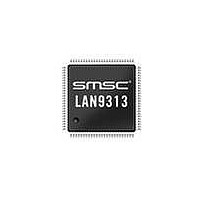LAN9313-NZW SMSC, LAN9313-NZW Datasheet - Page 139

LAN9313-NZW
Manufacturer Part Number
LAN9313-NZW
Description
Ethernet ICs Three Port 10/100 Ethernet Switch
Manufacturer
SMSC
Type
Three Port Managed Ethernet Switchr
Datasheet
1.LAN9313-NZW.pdf
(399 pages)
Specifications of LAN9313-NZW
Ethernet Connection Type
10 Base-T, 100 Base-TX
Minimum Operating Temperature
0 C
Mounting Style
SMD/SMT
Product
Ethernet Switches
Number Of Transceivers
1
Standard Supported
802.3, 802.3u
Data Rate
10 Mbps, 100 Mbps
Supply Voltage (max)
3.6 V
Supply Voltage (min)
0 V
Supply Current (max)
155 mA, 270 mA
Maximum Operating Temperature
+ 70 C
Package / Case
TQFP-100
Lead Free Status / RoHS Status
Lead free / RoHS Compliant
Available stocks
Company
Part Number
Manufacturer
Quantity
Price
Company:
Part Number:
LAN9313-NZW
Manufacturer:
Microchip Technology
Quantity:
10 000
Part Number:
LAN9313-NZW
Manufacturer:
SMSC
Quantity:
20 000
- Current page: 139 of 399
- Download datasheet (5Mb)
Three Port 10/100 Managed Ethernet Switch with MII
Datasheet
SMSC LAN9313/LAN9313i
10.3
IEEE 1588 CLOCK
The 64-bit IEEE 1588 clock is the time source for all IEEE 1588 related functions of the
LAN9313/LAN9313i. It is readable and writable by the host via the
(1588_CLOCK_HI)
In order to accurately read this clock, a special procedure must be followed. Since two DWORD reads
are required to fully read the 64-bit clock, the possibility exists that as the lower 32-bits roll over, a
wrong intermediate value could be read. To prevent this, a snapshot register technique is used. When
the 1588_CLOCK_SNAPSHOT bit in the
“1”, the current value of the 1588 clock is saved, allowing it to be properly read.
When writing a new value to the IEEE 1588 clock, two 32-bit write cycles are required (one for each
clock register) before the registers are affected. The writes may be in any order. However, caution must
be observed when changing the clock value in a live environment as it will disrupt linear time. If the
clock must be adjusted during operation of the 1588 protocol, it is preferred to adjust the Addend value,
effectively speeding-up or slowing-down the clock until the correct time is achieved.
T h e 6 4 - b i t I E E E 1 5 8 8 c l o c k c o n s i s t s o f t h e 3 2 - b i t
(1588_CLOCK_ADDEND)
of the Accumulator, the 64- bit IEEE 1588 clock is incremented. The Addend / Accumulator pair form
a high precision frequency divider which can be used to compensate for the inaccuracy of the
reference crystal. The nominal frequency of the 64-bit IEEE 1588 clock and the value of the Addend
are calculated as follows:
FreqClock = (Addend / 2
Addend = (FreqClock * 2
Typical values for the Addend are shown in
accuracy of the IEEE 1588 clock compared to the master clock per the PTP protocol. The adjustment
precision column of the table shows the percentage change for the specified IEEE 1588 clock
frequency if the Addend was to be incremented or decremented by 1.
IEEE 1588 Clock
(FreqClock)
33 MHz
50 MHz
66 MHz
75 MHz
90 MHz
Table 10.4 Typical IEEE 1588 Clock Addend Values
and
1588 Clock Low-DWORD Register
32
32
that is added to a 32-bit Accumulator every 100 MHz clock. Upon overflow
) * 100 MHz
) / 100 MHz
DATASHEET
1588_CLOCK_ADDEND
1588 Command Register (1588_CMD)
A8F5C28Fh
139
547AE147h
C0000000h
E6666666h
80000000h
(Addend)
Table
10.4. These values should be adjusted based on the
(1588_CLOCK_LO).
1 5 8 8 C l o c k A d d e n d R e g i s t e r
1588 Clock High-DWORD Register
ADJUSTMENT PRECISION %
7.1*10
4.7*10
3.5*10
3.1*10
2.6*10
register is written with
Revision 1.7 (06-29-10)
-8
-8
-8
-8
-8
Related parts for LAN9313-NZW
Image
Part Number
Description
Manufacturer
Datasheet
Request
R

Part Number:
Description:
Ethernet ICs Three Port 10/100 Ethernet Switch
Manufacturer:
SMSC
Datasheet:

Part Number:
Description:
FAST ETHERNET PHYSICAL LAYER DEVICE
Manufacturer:
SMSC Corporation
Datasheet:

Part Number:
Description:
357-036-542-201 CARDEDGE 36POS DL .156 BLK LOPRO
Manufacturer:
SMSC Corporation
Datasheet:

Part Number:
Description:
357-036-542-201 CARDEDGE 36POS DL .156 BLK LOPRO
Manufacturer:
SMSC Corporation
Datasheet:

Part Number:
Description:
357-036-542-201 CARDEDGE 36POS DL .156 BLK LOPRO
Manufacturer:
SMSC Corporation
Datasheet:

Part Number:
Description:
4-PORT USB2.0 HUB CONTROLLER
Manufacturer:
SMSC Corporation
Datasheet:

Part Number:
Description:
Manufacturer:
SMSC Corporation
Datasheet:

Part Number:
Description:
Manufacturer:
SMSC Corporation
Datasheet:

Part Number:
Description:
FDC37C672ENHANCED SUPER I/O CONTROLLER WITH FAST IR
Manufacturer:
SMSC Corporation
Datasheet:

Part Number:
Description:
COM90C66LJPARCNET Controller/Transceiver with AT Interface and On-Chip RAM
Manufacturer:
SMSC Corporation
Datasheet:

Part Number:
Description:
Manufacturer:
SMSC Corporation
Datasheet:

Part Number:
Description:
Manufacturer:
SMSC Corporation
Datasheet:

Part Number:
Description:
Manufacturer:
SMSC Corporation
Datasheet:

Part Number:
Description:
Manufacturer:
SMSC Corporation
Datasheet:











